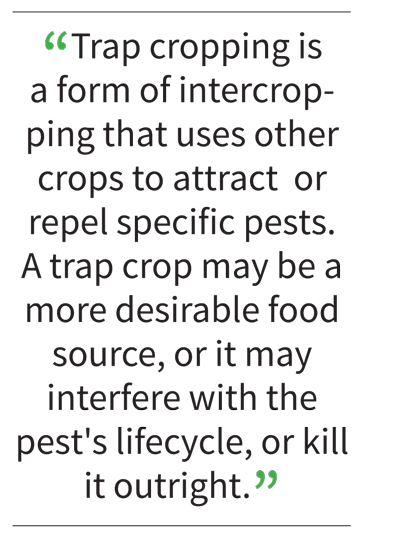Multiple trap cropping uses several species to lure pests throughout a valuable crop’s life cycle
Photo courtesy eOrganic.com
By Kate Russell

Kate Russell
Every year, we plant our garden favorites in Morgan Hill. And every year, the same pests come, causing damage and carrying disease. What if there was a way to lure those pests away from your plants?
There is. It’s called trap cropping.
Trap cropping is a form of intercropping that uses other crops to attract or repel specific pests. A trap crop may be a more desirable food source, or it may interfere with the pest’s life cycle, or kill it outright.
There are several types of trap cropping. Very often, trap cropping methods are used in combination, improving their effectiveness. These methods reduce the need for chemical pesticides, while increasing biodiversity in your landscape.
Conventional trap cropping places an attractive low value crop next to a high value crop. You might plant collards near cabbages to protect against diamondback moths, or plant mustard between rows of broccoli to lure flea beetles away.
 Perimeter trap cropping occurs when an attractant plant is grown around the perimeter of a cash crop, surrounding it completely. This barrier interrupts pests before they ever reach the high value crop. One popular perimeter trap crop is the use of hot cherry peppers planted around bell peppers to thwart pepper maggots. Or, Blue Hubbard squash is planted around summer squash, reducing damage from cucumber beetles by 95 percent.
Perimeter trap cropping occurs when an attractant plant is grown around the perimeter of a cash crop, surrounding it completely. This barrier interrupts pests before they ever reach the high value crop. One popular perimeter trap crop is the use of hot cherry peppers planted around bell peppers to thwart pepper maggots. Or, Blue Hubbard squash is planted around summer squash, reducing damage from cucumber beetles by 95 percent.
Sequential trap cropping installs attractive plants before high value crops. Strawberries are protected against wireworms when wheat is planted in the same bed eight days ahead of time.
Multiple trap cropping uses several species to lure pests throughout a valuable crop’s life cycle. For example, flea beetles have been repelled when scallions, dill, and marigolds are planted nearby, and stinkbug and leaf-footed bug control is provided when a cash crop is surrounded with sorghum, millet, buckwheat, and sunflowers.
Push-pull trap cropping surrounds a cash crop with an attractant, and intercrops it with a repellent. One highly effective combination, for growing corn, is to surround a field with fountain grasses and to intercrop with tick clover.
Dead-end trap cropping lures pests away from cash crops, but then fails to provide sustenance to their larval forms. Cowpeas and soybeans can be protected against bean pod borers by planting brown hemp (‘Crotalaria juncae’) nearby. And if you have problems with Japanese beetles eating your roses, try installing Pelargonium geraniums nearby. The beetles will feed on the geraniums and die.
Biological control assisted trap cropping lures beneficial predators to attractive perimeter crops, where they can then feed on the pests. For example, cotton fields may be surrounded with plantings of sorghum, providing protection against bollworms.
Which crops have the biggest pest problems in your garden? And how can you use trap cropping to protect them?
Kate Russell is a UCCE Master Gardener in Santa Clara County. For more information, visit mgsantaclara.ucanr.edu or call (408) 282-3105 between 9:30 a.m. and 12:30 p.m., Monday through Friday.






